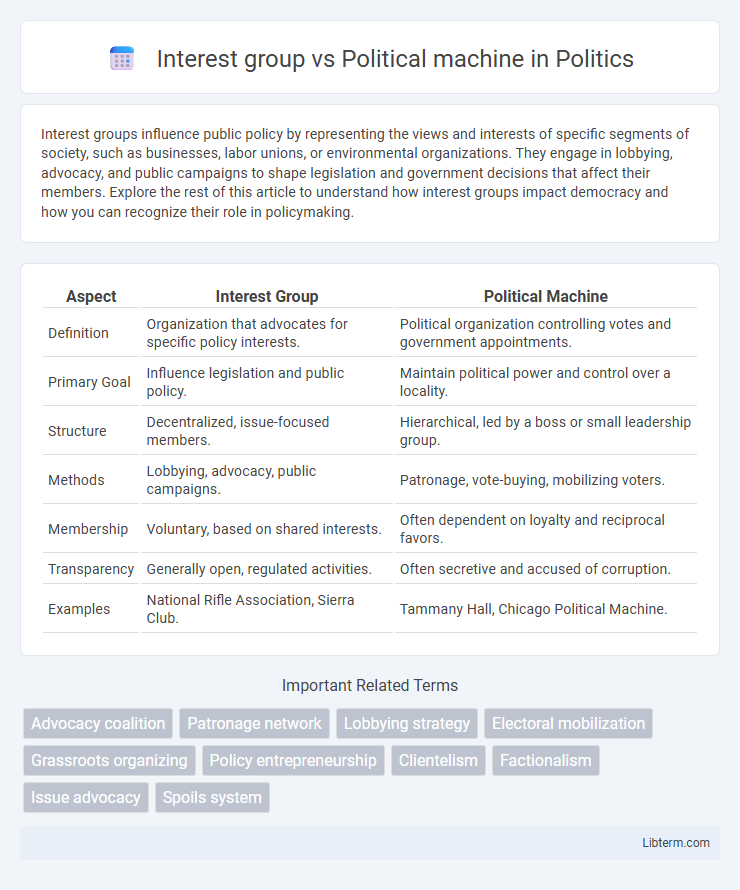Interest groups influence public policy by representing the views and interests of specific segments of society, such as businesses, labor unions, or environmental organizations. They engage in lobbying, advocacy, and public campaigns to shape legislation and government decisions that affect their members. Explore the rest of this article to understand how interest groups impact democracy and how you can recognize their role in policymaking.
Table of Comparison
| Aspect | Interest Group | Political Machine |
|---|---|---|
| Definition | Organization that advocates for specific policy interests. | Political organization controlling votes and government appointments. |
| Primary Goal | Influence legislation and public policy. | Maintain political power and control over a locality. |
| Structure | Decentralized, issue-focused members. | Hierarchical, led by a boss or small leadership group. |
| Methods | Lobbying, advocacy, public campaigns. | Patronage, vote-buying, mobilizing voters. |
| Membership | Voluntary, based on shared interests. | Often dependent on loyalty and reciprocal favors. |
| Transparency | Generally open, regulated activities. | Often secretive and accused of corruption. |
| Examples | National Rifle Association, Sierra Club. | Tammany Hall, Chicago Political Machine. |
Defining Interest Groups and Political Machines
Interest groups are organizations that seek to influence public policy and decision-making by representing specific interests or causes, typically through advocacy, lobbying, and public campaigns. Political machines are highly organized political entities that maintain control over a city's or region's political system by mobilizing voters, often through patronage, favors, and strict hierarchical control. While interest groups focus on advancing particular policy goals, political machines prioritize maintaining political power and delivering votes.
Historical Origins and Evolution
Interest groups originated in the early 19th century as organized advocacy coalitions aimed at influencing public policy through lobbying and grassroots mobilization. Political machines evolved in the late 19th and early 20th centuries, characterized by hierarchical party organizations that controlled local politics through patronage and voter loyalty. While interest groups emphasize issue-specific advocacy, political machines maintained power by exchanging services and favors, shaping urban political landscapes during the Gilded Age.
Core Functions and Objectives
Interest groups primarily focus on influencing public policy and representing the specific interests of their members through lobbying, advocacy, and public campaigns. Political machines concentrate on maintaining political power by mobilizing voter support, distributing favors, and controlling local government appointments. While interest groups seek policy changes benefiting particular issues or sectors, political machines aim to secure electoral dominance and patronage networks.
Organizational Structure and Leadership
Interest groups typically feature decentralized organizational structures with specialized committees or divisions focused on advocacy, lobbying, and member engagement, allowing for flexible leadership often distributed among elected directors or professional staff. Political machines exhibit highly centralized hierarchies dominated by a strong, authoritative leader who controls party loyalty and political appointments through a top-down command system, ensuring disciplined voter mobilization and resource allocation. Leadership in interest groups emphasizes expertise and issue advocacy, whereas political machine leaders prioritize loyalty, patronage, and maintaining power within urban political networks.
Tactics and Influence in Politics
Interest groups utilize lobbying, grassroots mobilization, and media campaigns to influence legislation and policy decisions by targeting specific issues and policymakers. Political machines rely on patronage, vote-buying, and strong party organization to control elections and maintain power within local governments. While interest groups shape public policy through advocacy and expertise, political machines exert influence by securing voter loyalty and distributing resources for political gain.
Membership and Recruitment Strategies
Interest groups typically recruit members through targeted campaigns appealing to shared values, professions, or causes, often relying on voluntary participation and grassroots mobilization. Political machines, by contrast, employ hierarchical, patronage-based recruitment strategies, offering tangible incentives such as jobs or favors in exchange for loyalty and votes. Membership in interest groups tends to be more inclusive and focused on advocacy, whereas political machines maintain control through tightly organized, loyalty-driven networks.
Impact on Policy and Legislation
Interest groups influence policy and legislation by lobbying lawmakers, funding campaigns, and mobilizing voters to align laws with their specific agendas, often representing diverse and issue-specific constituencies. Political machines, on the other hand, rely on centralized control, patronage, and voter mobilization within urban areas to maintain power and enact policies that favor their organizational interests, typically prioritizing loyalty over broad public input. The impact of interest groups tends to be targeted and policy-specific, while political machines shape legislation through entrenched political control and reciprocal networks.
Role in Elections and Voter Mobilization
Interest groups primarily influence elections by lobbying candidates and funding campaigns to promote specific policy agendas, while political machines directly control voter mobilization through organized local networks and patronage systems. Political machines ensure high voter turnout by offering tangible incentives like jobs or services, effectively consolidating votes for their preferred candidates. Interest groups, on the other hand, mobilize voters by shaping public opinion and providing information to align electoral outcomes with their goals.
Advantages and Criticisms
Interest groups effectively represent specific policy preferences, mobilizing public support and providing expertise to lawmakers, which enhances democratic participation. However, they face criticism for promoting narrow agendas that may lead to unequal influence and exacerbate political polarization. Political machines can efficiently organize voter turnout and deliver services, but they are often criticized for fostering corruption, patronage, and undermining democratic processes.
Key Differences Between Interest Groups and Political Machines
Interest groups are organized collections of individuals or organizations aiming to influence public policy through advocacy, lobbying, and public campaigns, while political machines are hierarchical party organizations that maintain power by mobilizing voters and providing services in exchange for political support. Interest groups operate independently of government control and focus on specific issues, whereas political machines typically control local or regional governments through patronage and vote-buying. The primary distinction lies in their methods and goals: interest groups seek policy influence, while political machines seek direct political power and governance control.
Interest group Infographic

 libterm.com
libterm.com